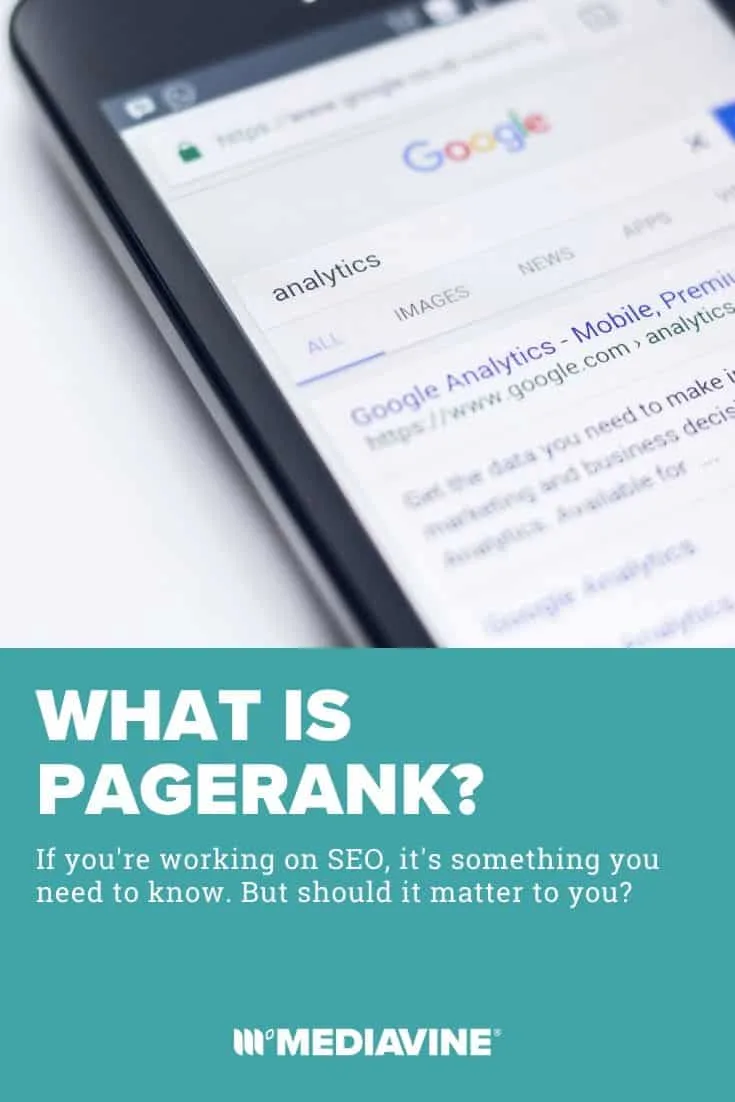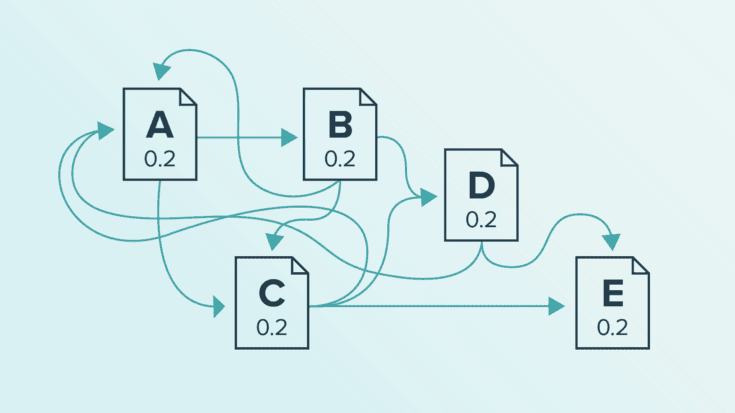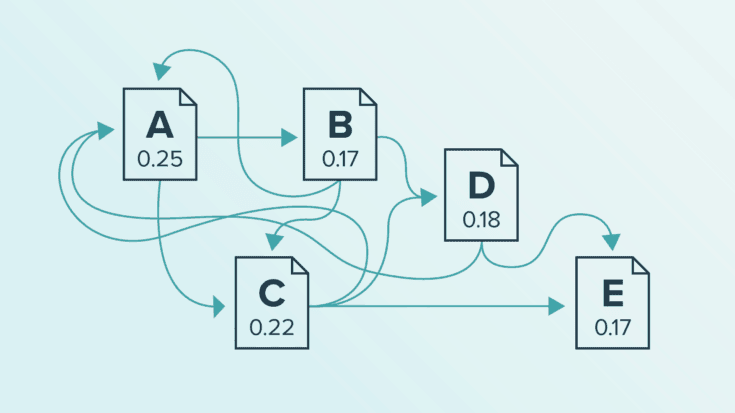PageRank: Why Links Are So Important


PageRank is the original Google Search algorithm, written by Google co-founders Larry Page and Sergey Brin while at Stanford. To oversimplify its concept, PageRank uses links to evaluate the importance of pages and determine their ordering in search results.
As the original and most important factor in Google Search, we’d be remiss to not discuss PageRank in our SEO series. Even though it’s no longer the most talked-about ranking signal, the fundamentals behind PageRank are still important and relevant to this day.
PageRank is a clever play on the name of Google co-founder Larry Page. It also refers to the concept of PageRank, which looks at the web as a series of web pages, as opposed to websites.

We can’t emphasize enough that this example (and entire article) involves simplifying a remarkably complex subject for instructional purposes.
With that disclaimer, our breakdown of the PageRank algorithm involves a world with five pages on the entire Internet: A, B, C, D and E.
Each page starts off with a PageRank of 1/n, where n is the total number of pages on the Internet.
In our example, the total number of pages online is five, giving each a starting PageRank of 1/5, or 0.2.
Google’s web crawler is then going to crawl each of these pages and look for the links on the pages.

You can think of links as “votes” for other web pages, and unlike local elections, you get multiple votes. The impact of these votes vary widely, however.
If you vote for two things, you split your vote — like casting “half” votes for two objects. Vote for three things? Each only gets one-third of your votes.
So back to our example above.
Let’s say Page A links to B and C. Google is now going to transfer its 0.2 PageRank equally to B and C, so each will receive 0.1.
Page B now has the original 0.2 it began with, PLUS 0.1, for 0.3 total.
Page B now gets to casts its votes. B links back to A, but also to C and B. Divide that 0.3 by 3, and we can pass on 0.1 to each of the pages B voted for.
We repeat this process for each page and after that round, everyone will have a new PageRank.
As we continue to repeat the process, we apply what’s called a “damping factor” so that eventually, the votes stop and the numbers begin to stabilize.
In the end of this process, we’ll find that Page A ends up being the most popular due to all the votes it got from the other pages.
Meanwhile, B and E ended up with the lowest PageRank. While B received a link from A, the highest ranking page in our example, it only had one link, which was equal to the two that E received, tying those two pages for last.

Pretty cool how that worked out, right? We now have rankings ranging from 0.17-0.25 for our five pages.
But wait… does anyone remember the old Google toolbar? PageRank was always a score of 1 to 10.
That toolbar figure was just a simplified, relative display of PageRank in which the most popular web pages would score 10, and the least popular would score 0 if they had no incoming links at all.
Scaling every score into whole numbers relative to other pages gave users the opportunity to view PageRank more simply and usefully. Think of it this way: Which makes it clearer that Page A was our most popular, a 0.25 score out of 0.25 or a 10 out of 10?
If your eyes are glazed over from this example, imagine doing it for trillions of pages — and using the actual formula, not my basic simplified model.

People can debate in 2020 how important PageRank is in the current Google algorithm, or if it’s even still used at all in its original form. There’s no mistaking that links still play a key role in Search Results, however.
Don’t believe me? Believe Google itself. The company’s SEO Starter Guide mentions “link” 80 times and literally starts with its advice: Help Google find your content either with a sitemap or links.
Links matter. Understanding PageRank will help you understand how and why links matter.
It’s actually all published by Stanford, where Page and Brin came up with this algorithm while researching a new search engine at the University.
You can read Larry Page’s “PageRank: Bringing Order to the Web” paper at Stanford to get the full formula and algorithm information, and our example ranking example from a Google PageRank Algorithm handout by Eric Roberts for the Stanford CD 54N class.

There’s four key takeaways from PageRank that I believe are helpful and relevant to all of you right now. That the concepts are still important whether PageRank specifically is or not.
Linking to something is voting for that page in Google’s eye. Every time you link to any page, you are signaling to Google that you trust and recommend that page to users.
In our example above, we simply identified things as pages — not websites. That’s how PageRank evaluates the web. Everything is just a page. That means, yes, your pages can and should link to your own pages, and those votes count!
You can vote for yourself around the clock, but no man is an island.
That guy in the corner voting for himself doesn’t matter if no one else voted for him first. You need the popular people with lots of votes to vote for you. Remember, it’s not just number of links that matter, it’s the source — WHO is linking to YOU?
I can’t stress this enough.
Your votes are divided amongst every page you’re linking to from a page. If you’re voting for an external page, make sure it’s a high quality one that you trust. Then make sure you also vote for yourself plenty of times on that same page so you’re not passing on all of your votes.
Still overwhelmed? Don’t be.
We’ll be covering so much more on linking and SEO over the coming months. PageRank is just something to keep in the back of your mind. What matters most is that you’re following linking best practices, like using useful anchor text.
Why? Because PageRank, although still likely a part of the Google algorithm, is just one of many ranking signals Google has added since its inception.
We’ll be back soon with another post in the SEO Like A CEO series. Subscribe to our YouTube Channel to catch all our videos in this series.
Stay up to date with the latest from Mediavine
 Eric Hochberger
Eric Hochberger
Google recently announced that any publisher passing the new Page Experience algorithm will be considered for the top story carousels in Google News. This shift comes after years of Google …
 Eric Hochberger
Eric Hochberger
Whether it’s for SEO or monetization purposes, we always encourage publishers to update old content. We’ve discussed at length how specifically to update content to improve RPM and optimize for …
 Eric Hochberger
Eric Hochberger
Today on the Mediavine blog, we’re throwing it back to 2017, famously known to SEO experts across the web as the Year of the Parboil. It was never actually known …